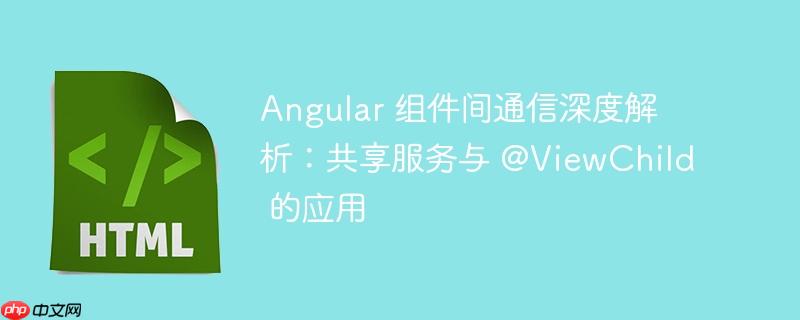
在 Angular 应用中,组件是构建用户界面的基本单元。随着应用复杂度的增加,组件之间的数据共享和方法调用变得至关重要。Angular 提供了多种通信机制来满足不同场景的需求。本文将重点介绍两种常见且强大的通信模式:基于共享服务(Service)的发布/订阅模式和基于 @ViewChild 的父子组件直接交互。
共享服务是 Angular 中实现非父子组件间通信的推荐方式,它基于发布/订阅(Publish/Subscribe)模式,能够实现组件间的松耦合。当两个组件之间没有直接的父子关系,或者需要跨多个层级进行通信时,共享服务是理想的选择。
核心原理:
通过在共享服务中定义一个可观察对象(Observable),如 Subject 或 BehaviorSubject,一个组件可以向其发送数据(发布),而另一个组件则可以订阅这个可观察对象来接收数据(订阅)。
1. 创建共享服务
首先,定义一个可注入的服务,其中包含用于发送和接收数据的方法。
// src/app/main.service.ts
import { Injectable } from '@angular/core';
import { BehaviorSubject, Observable, Subject } from 'rxjs';
@Injectable({
providedIn: 'root' // 确保服务在整个应用中是单例的
})
export class MainService {
// BehaviorSubject 会在订阅时立即发出当前值(或初始值)
// private messageSource = new BehaviorSubject<string>("111");
// Subject 不会发出初始值,只会在有新值发出时通知订阅者
private messageSource = new Subject<string>();
/**
* 发送消息
* @param mess 要发送的字符串消息
*/
sendMessage(mess: string): void {
this.messageSource.next(mess);
}
/**
* 接收消息的 Observable
* @returns 消息的 Observable
*/
receiveMessage(): Observable<string> {
return this.messageSource.asObservable();
}
}BehaviorSubject 与 Subject 的选择:
2. 发送方组件
在需要发送数据的组件中,注入 MainService 并调用 sendMessage 方法。
// src/app/first/first.component.ts
import { Component } from '@angular/core';
import { MainService } from '../main.service';
@Component({
selector: 'app-first',
template: `
<button (click)="clickMe()">点击我发送消息</button>
`
})
export class FirstComponent {
constructor(private service: MainService) {}
clickMe(): void {
this.service.sendMessage("001");
console.log("消息 '001' 已发送。");
}
}3. 接收方组件
在需要接收数据的组件中,注入 MainService,并在组件初始化时订阅 receiveMessage 方法返回的 Observable。
// src/app/second/second.component.ts
import { Component, OnInit, OnDestroy } from '@angular/core';
import { MainService } from '../main.service';
import { Subscription } from 'rxjs';
@Component({
selector: 'app-second',
template: `
<p>接收到的消息将显示在控制台。</p>
`
})
export class SecondComponent implements OnInit, OnDestroy {
private messageSubscription!: Subscription;
constructor(private service: MainService) {}
ngOnInit(): void {
// 订阅消息
this.messageSubscription = this.service.receiveMessage().subscribe(message => {
this.toggle(message);
});
}
public toggle(state: string): void {
console.log("SecondComponent 收到消息:", state);
}
ngOnDestroy(): void {
// 销毁组件时取消订阅,防止内存泄漏
if (this.messageSubscription) {
this.messageSubscription.unsubscribe();
}
}
}注意事项:
当组件之间存在明确的父子关系时,父组件可以直接通过 @ViewChild 装饰器获取子组件的实例,从而直接调用子组件的方法或访问其属性。这种方式适用于父组件需要直接控制子组件行为的场景。
核心原理:
@ViewChild 装饰器允许父组件在视图初始化后获取模板中特定子组件或 DOM 元素的引用。一旦获取到子组件的引用,父组件就可以像操作普通对象一样调用子组件的公共方法。
1. 子组件(SecondComponent)
子组件需要暴露一个公共方法供父组件调用。
// src/app/second/second.component.ts
import { Component } from '@angular/core';
@Component({
selector: 'app-second',
template: `
<p>我是一个子组件。</p>
`
})
export class SecondComponent {
constructor() {}
/**
* 子组件的公共方法,用于接收父组件传递的状态
* @param state 父组件传递的字符串状态
*/
public toggle(state: string): void {
console.log("SecondComponent 收到来自父组件的直接调用,状态:", state);
}
}2. 父组件(FirstComponent)
父组件需要将子组件作为其模板的一部分,并使用 @ViewChild 装饰器来获取子组件的引用。
// src/app/first/first.component.ts
import { Component, ViewChild, AfterViewInit } from '@angular/core';
import { SecondComponent } from '../second/second.component'; // 导入子组件
@Component({
selector: 'app-first',
template: `
<button (click)="clickMe()">点击我调用子组件方法</button>
<app-second></app-second> <!-- 在父组件模板中嵌入子组件 -->
`
})
export class FirstComponent implements AfterViewInit {
// 使用 @ViewChild 获取 SecondComponent 的实例
// static: true 表示在变更检测周期的第一次运行时解析查询
// static: false (默认) 表示在视图初始化后解析查询 (适用于 ngIf/ngFor 动态添加的组件)
@ViewChild(SecondComponent, { static: false }) secondChildView!: SecondComponent;
constructor() {}
ngAfterViewInit(): void {
// 确保 secondChildView 在这里已经可用
// console.log("SecondChildView:", this.secondChildView);
}
clickMe(): void {
if (this.secondChildView) {
this.secondChildView.toggle('001'); // 直接调用子组件的 toggle 方法
console.log("已通过 @ViewChild 调用子组件方法并传递 '001'。");
} else {
console.error("SecondComponent 实例未找到,可能视图尚未初始化。");
}
}
}注意事项:
共享服务(Service):
@ViewChild:
Angular 提供了灵活多样的组件通信机制。对于非父子关系或需要松耦合的组件,共享服务(特别是结合 Subject 或 BehaviorSubject)是首选,它提供了强大的发布/订阅模式。而对于明确的父子关系,当父组件需要直接调用子组件的方法时,@ViewChild 提供了一种简洁高效的解决方案。理解这两种模式的原理和适用场景,将帮助你构建更健壮、可维护的 Angular 应用。在实际开发中,根据组件间的关系和通信需求,选择最合适的通信策略至关重要。
以上就是Angular 组件间通信深度解析:共享服务与 @ViewChild 的应用的详细内容,更多请关注php中文网其它相关文章!

每个人都需要一台速度更快、更稳定的 PC。随着时间的推移,垃圾文件、旧注册表数据和不必要的后台进程会占用资源并降低性能。幸运的是,许多工具可以让 Windows 保持平稳运行。

Copyright 2014-2025 https://www.php.cn/ All Rights Reserved | php.cn | 湘ICP备2023035733号